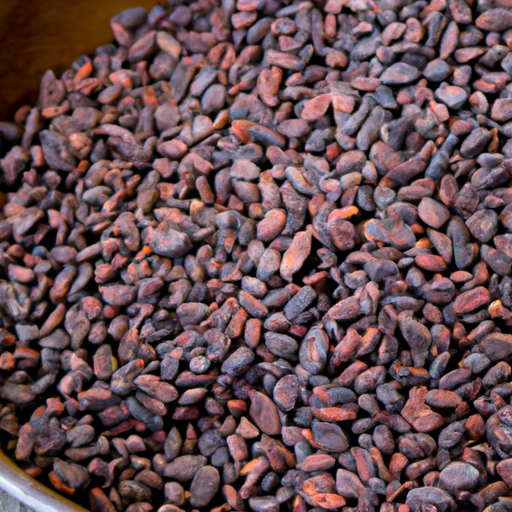When I indulge in a piece of decadent dark chocolate, I feel a wave of comfort and enjoyment. However, I can’t help but wonder: how much caffeine is in raw cacao?
This inquiry is not only fueled by curiosity, but also by a desire to make informed choices about my caffeine intake. In this article, we will explore the world of raw cacao and uncover the truth about its caffeine content.
By delving into the science behind caffeine and its effects on the body, we can better understand how raw cacao fits into our daily lives. Along the way, we will also discuss health considerations, alternative options for a caffeine boost, and the importance of sustainability in the chocolate industry.

So join me on this journey as we unravel the mysteries of raw cacao and its caffeine content.
Key Takeaways
- Raw cacao is a natural stimulant that contains approximately 12 milligrams of caffeine per ounce.
- Roasting can decrease the caffeine content of raw cacao.
- Individual variations in caffeine metabolism can affect the levels of caffeine in raw cacao.
- Excessive intake of raw cacao can lead to side effects like irritability and anxiety.
What is Raw Cacao?
Raw cacao is the purest form of chocolate, made by cold-pressing unroasted cacao beans. It retains more of its natural nutrients and antioxidants compared to cocoa powder, which is processed at high temperatures. This makes raw cacao a powerhouse of health benefits. It is packed with minerals like magnesium, iron, and zinc, which are essential for overall well-being. Raw cacao also contains flavonoids, which have been linked to improved heart health and reduced inflammation. Additionally, it is known to boost mood and increase focus due to its natural stimulant properties. With its numerous health benefits, raw cacao is a superfood worth incorporating into your diet.
Caffeine Content in Raw Cacao
When discussing the caffeine content in raw cacao, it’s important to compare it to other common sources of caffeine, such as coffee and tea.
There are several factors that can affect the levels of caffeine in raw cacao. These include the variety of cacao bean used, the processing methods, and the brewing or preparation techniques.
Understanding these factors can help determine the overall caffeine content in raw cacao and its potential effects on the body.
Comparison to coffee and tea
If you’re looking for a natural alternative to coffee or tea, you’ll be intrigued to know just how much caffeine raw cacao packs. Raw cacao is often touted as a healthier choice due to its potential health benefits. When it comes to caffeine content, raw cacao falls somewhere in between coffee and tea.
While a cup of coffee typically contains around 95 milligrams of caffeine and a cup of tea contains around 47 milligrams, raw cacao contains approximately 12 milligrams per ounce. While this may not give you the same energy boost as a cup of coffee, it can still provide a gentle pick-me-up without the jitters.
So, if you’re looking to cut down on your caffeine intake but still want a little boost, raw cacao could be a great option. Now let’s explore the factors that affect caffeine levels in raw cacao.
Factors that affect caffeine levels in raw cacao
One key factor that can influence the caffeine levels in raw cacao is the roasting process. When cacao beans are roasted, their caffeine content can decrease because high temperatures can cause the breakdown of caffeine molecules. The duration and intensity of the roasting process can also affect the caffeine levels.
Factors affecting caffeine absorption and metabolism rates can also play a role in the overall caffeine content of raw cacao. For example, individuals with certain genetic variations may metabolize caffeine more slowly, resulting in higher caffeine levels in their bodies after consuming raw cacao.
Understanding these factors is important when considering the potential effects of caffeine on the body. Transitioning into the subsequent section about the ‘effects of caffeine on the body’, it is crucial to explore how different factors can influence the way caffeine affects us.
Effects of Caffeine on the Body
Did you know that caffeine in raw cacao can have various effects on your body? Here are three important ways in which caffeine can impact your health:
Effects on sleep: Consuming caffeine, including that found in raw cacao, can interfere with your sleep patterns. It stimulates the nervous system, making it harder to fall asleep and reducing the quality of your sleep.
Mental alertness: Caffeine is known for its ability to increase alertness and improve concentration. It works by blocking adenosine, a neurotransmitter that promotes relaxation and sleepiness, leading to a temporary boost in energy and mental focus.
Other considerations: While caffeine can have positive effects on mental alertness, it is important to consume it in moderation. Excessive caffeine intake can lead to side effects such as irritability, anxiety, and even heart palpitations.
Considering the effects of caffeine on the body, it is important to also explore the health considerations associated with consuming raw cacao.
Health Considerations
After discussing the effects of caffeine on the body, let’s now delve into some health considerations when it comes to consuming raw cacao.
As a caffeine alternative, raw cacao offers a range of health benefits. It contains a moderate amount of natural caffeine, which can provide a gentle energy boost without the jitters or crashes associated with coffee or energy drinks.
Additionally, raw cacao is rich in antioxidants, which help fight inflammation and protect against chronic diseases like heart disease and cancer. It also contains minerals like magnesium, iron, and potassium, which are essential for various bodily functions.
Incorporating raw cacao into your diet can be a tasty and nutritious way to enjoy the benefits of caffeine without relying solely on coffee or other caffeinated beverages.
Now, let’s explore how caffeine and chocolate cravings are connected.
Caffeine and Chocolate Cravings
If you’re a chocolate lover, you’ll be intrigued to discover the intriguing connection between caffeine and your irresistible chocolate cravings.
Raw cacao, the main ingredient in chocolate, contains a moderate amount of caffeine that can affect your energy levels. Caffeine is a stimulant that can increase alertness and boost your mood. However, consuming excessive amounts of caffeine can lead to addiction and withdrawal symptoms, such as headaches and irritability.
It’s important to be mindful of your caffeine intake and listen to your body’s needs. If you’re looking for alternative options for a caffeine boost, there are plenty of delicious and nutritious alternatives available. These options can provide you with the energy you need without relying solely on caffeine.
Alternative Options for Caffeine Boost
Looking for a way to boost your energy without relying on caffeine? There are several alternative sources of caffeine that can provide a natural energy boost. Here are three options to consider:
Green tea: It contains a moderate amount of caffeine and is also rich in antioxidants, which can help improve brain function and increase alertness.
Ginseng: This herbal supplement has been used for centuries to enhance energy levels and reduce fatigue. It can be taken in capsule form or brewed as a tea.
Maca root: This adaptogenic herb is known for its ability to increase stamina and combat fatigue. It can be consumed in powder form, added to smoothies or baked goods.
Incorporating raw cacao in your diet is another great way to boost your energy levels. Stay tuned to learn more about the caffeine content in raw cacao and its benefits.
Incorporating Raw Cacao in Your Diet
When it comes to incorporating raw cacao in my diet, I have found some delicious recipes and ideas that I can’t wait to share.
From smoothies to desserts, there are endless possibilities for using raw cacao to add a rich and chocolatey flavor to my meals.
Additionally, I have learned some valuable tips for finding high-quality raw cacao products, ensuring that I am getting the best possible taste and nutritional benefits from this superfood.
Recipes and ideas for using raw cacao
One great way to incorporate raw cacao into your diet is by trying out delicious recipes. You can make raw cacao smoothies or raw cacao energy balls. These recipes not only satisfy your sweet tooth but also provide you with the numerous health benefits of raw cacao.
Here are five ideas to get you started:
- Raw cacao smoothie bowl topped with fresh fruits and nuts.
- Raw cacao bliss balls made with dates, nuts, and a sprinkle of coconut.
- Raw cacao chia pudding, a creamy and nutritious treat.
- Raw cacao hot chocolate made with almond milk and a touch of maple syrup.
- Raw cacao protein bars packed with nuts, seeds, and a hint of vanilla.
Incorporating these recipes into your routine will not only satisfy your chocolate cravings but also provide you with the antioxidant-rich goodness of raw cacao.
Now, let’s move on to some tips for finding high-quality raw cacao products.
Tips for finding high-quality raw cacao products
To ensure you’re getting the best quality raw cacao products, it’s important to be mindful of the source and processing methods used.
When searching for reputable brands, look for those that prioritize fair trade practices and sustainable farming methods. This ensures that the cacao beans are grown and harvested in an environmentally friendly and socially responsible manner.
Additionally, consider the processing methods used by the brand. Look for products that are minimally processed and free from additives or preservatives.
By choosing high-quality raw cacao products, you can maximize the potential benefits it offers, such as its antioxidant properties and mood-boosting effects.
Now, let’s delve into the next section about the chocolate industry and sustainability.
The Chocolate Industry and Sustainability
The chocolate industry is constantly growing, but how sustainable is it?
Chocolate production has been linked to deforestation, particularly in regions where cacao is harvested. As demand for chocolate increases, more forests are cleared to make way for cacao plantations, leading to habitat loss for many species.
However, there is a growing movement towards fair trade and ethical sourcing in the chocolate industry. Companies are now seeking out cacao beans from farmers who practice sustainable farming methods and provide fair wages to their workers. These efforts not only help protect the environment but also support local communities.
In conclusion, while the chocolate industry still faces challenges in terms of sustainability, there are positive steps being taken towards a more ethical and environmentally friendly approach to chocolate production.
Conclusion and Final Thoughts
Now that you’ve learned about the sustainability efforts in the chocolate industry, you can feel good about indulging in your favorite treat. Steps are being taken to protect the environment and support local communities. The chocolate industry has made significant progress in promoting sustainable practices. They source cocoa beans from certified farms and invest in programs that improve farmers’ livelihoods. This commitment to sustainability helps preserve delicate ecosystems where cocoa is grown and ensures a more equitable supply chain.
Apart from the environmental and social benefits, consuming raw cacao, the main ingredient in chocolate, can have positive effects on our health. Raw cacao is rich in antioxidants, minerals, and vitamins. These can support cardiovascular health, boost mood, and enhance cognitive function.
So, next time you enjoy a piece of chocolate made from raw cacao, savor it knowing that it not only tastes delicious but also offers potential health benefits.
Frequently Asked Questions
Can raw cacao be consumed by individuals who are sensitive to caffeine?
Yes, raw cacao can be consumed by individuals who are sensitive to caffeine. Decaffeinated cacao contains very little caffeine, making it a suitable alternative. Other caffeine-free options include carob powder and herbal teas.
What are the potential health benefits of consuming raw cacao?
Raw cacao has numerous potential health benefits. It is packed with antioxidants, which help fight free radicals and protect against chronic diseases. Additionally, it is a good source of minerals like magnesium and iron, and has been linked to improved mood and cognitive function.
Are there any side effects associated with consuming raw cacao?
Consuming raw cacao can have side effects, such as increased heart rate and anxiety, due to its caffeine content. Long-term effects of raw cacao consumption may include sleep disturbances and addiction to caffeine.
How does the caffeine content in raw cacao compare to other caffeinated beverages?
Move over coffee, raw cacao packs a punch! With a comparable caffeine content, it offers a healthier alternative to caffeinated beverages. Its rich antioxidant profile and mood-boosting properties make it a guilt-free indulgence.
Can raw cacao be used as a natural energy booster?
Raw cacao can be used as a natural energy booster due to its high levels of antioxidants and nutrients. It can improve mood and focus. Try incorporating raw cacao into recipes for a delicious and healthy treat.
Does the Fiber Content in Raw Cacao Powder Affect Its Caffeine Levels?
Yes, the fiber content in cacao powder can affect its caffeine levels. The presence of fiber in raw cacao powder can slow down the absorption of caffeine in the body, leading to a more sustained release of energy compared to processed forms of chocolate.
Conclusion
In conclusion, raw cacao is a delicious and natural source of caffeine that can provide a much-needed energy boost. With its rich flavor and numerous health benefits, it’s no wonder why so many people are turning to this superfood.
But, just how much caffeine does it contain? The answer is not as much as you may think. While raw cacao does contain some caffeine, it is significantly less than what you would find in a cup of coffee.
So, if you’re looking for a healthier alternative to your morning java, consider incorporating raw cacao into your diet. Not only will you enjoy the delicious taste, but you’ll also reap the benefits of its antioxidants and other nutrients.
So, the next time you’re craving a caffeine fix, why not give raw cacao a try? You may be pleasantly surprised by the results. After all, who doesn’t want a guilt-free way to indulge in chocolate while getting a little energy boost at the same time?

















